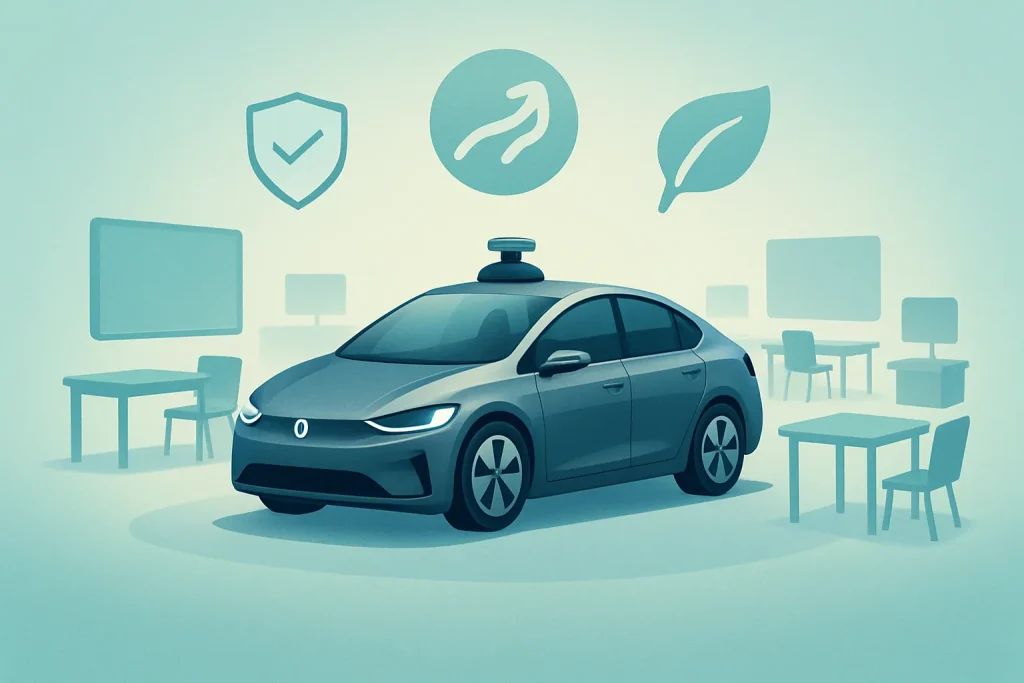Autonomous vehicles are poised to revolutionize transportation, but their success hinges on public understanding and acceptance. This article explores the crucial role of education in shaping the future of self-driving cars, drawing on insights from industry experts. From building trust through demonstrations to integrating ethics into AI development, discover the key educational strategies that will drive the autonomous vehicle revolution forward.
- Build Trust Through Education and Demonstrations
- Emphasize Human Oversight in Autonomous Vehicles
- Prepare for Imperfect Technology in Self-Driving Cars
- Highlight Safety Benefits of Autonomous Vehicles
- Develop Specialized Training for Autonomous Vehicle Technicians
- Update Curricula for Evolving Transportation Industry
- Utilize Virtual Reality for Autonomous Driving Education
- Integrate Ethics into AI and Autonomous Vehicle Development
Build Trust Through Education and Demonstrations
Public education will be just as important as the technology when it comes to bringing autonomous vehicles into everyday life. People need to understand how these vehicles actually work and what safety measures are in place, or they won’t trust them on the road.
The most important message to share is that ‘autonomous’ doesn’t mean there’s nobody in control. At least in the near future, there will still be human oversight, either someone in the driver’s seat, a remote operator, or a safety system ready to take over if conditions change.
When people hear ‘self-driving’, they often imagine a vehicle left completely on its own, and that’s what makes them nervous.
Clear demonstrations, real safety data, and simple explanations can help people see that autonomous vehicles are an upgrade to current systems, not a total handover to machines. If that understanding comes first, the public will be far more willing to accept the technology when it arrives.
 Ford Smith
Ford Smith
Founder & CEO, A1 Xpress
Emphasize Human Oversight in Autonomous Vehicles
The real message that needs to be gotten across, is that self-driving cars are computers on wheels and as such susceptible to the vagaries of computer errors, confounds and things like bad judgement. Smartphones crash and do funky things all of the time, which is acceptable—but it seems unreasonable to expect a similar level of tech integration into a 4,000-pound machine moving at 60-odd mph down the road without issue.
We see autonomous test vehicles at our yard all the time and I can guarantee you these self-drivers crash just like any other car out there. Last month, for example, we reported on an autonomous Uber that drove itself under the back-end of a pickup truck — blindsided by ambiguous road construction signs. In this particular case, the car’s pedestrian detection sensors confused the stationary traffic for parked cars on the side of the road and didn’t hit the brakes until it was too late.
It is important to realize that autonomous vehicles are designed to perform in perfect conditions, i.e. nice weather, clear lines on the roads and calm traffic streams. However, in construction, heavy rain or dealing with erratic drivers, like the one who tried to merge into a few seconds back on U.S. 31 North recently, it leaves something to be desired right now.
Instead of falling into the trap that AVs will end all wrecks, educational campaigns should focus on helping consumers understand what they can expect from this tech. Even though these types of vehicles can lower the number of accidents, they will probably be related to other kinds of crashes we did not have before. People should be ready to step in and maintain control, instead of just letting the vehicle drive for itself.
It must be, “autonomous vehicles are a support tool but you will always still be held to account. This does not mean that… OK for you to kick back and catch a nap while the robot takes over. That false sense of security can be deadly.
 MARC SKIRVIN
MARC SKIRVIN
President, Cash Auto Salvage
Prepare for Imperfect Technology in Self-Driving Cars
Education and public awareness will be crucial in building trust and reducing fear around autonomous vehicles. A key message to convey is: “Autonomous vehicles are designed to reduce human error — the leading cause of road accidents — and enhance safety for everyone on the road.”
 Shawn Miller
Shawn Miller
Blogger, Modified Rides
Highlight Safety Benefits of Autonomous Vehicles
As autonomous vehicles become more prevalent, training programs for technicians specializing in these advanced systems are becoming essential. These programs need to cover a wide range of topics, from basic mechanics to complex AI algorithms. Technicians must be equipped with the skills to diagnose, repair, and maintain the intricate components of self-driving cars. This specialized knowledge will be crucial for ensuring the safety and reliability of autonomous vehicles on our roads.
Educational institutions and automotive companies should collaborate to develop comprehensive training curricula that keep pace with rapidly evolving technology. It’s time for vocational schools and community colleges to integrate autonomous vehicle maintenance courses into their offerings. Students interested in the automotive industry should consider enrolling in these programs to prepare for the future of transportation.
Develop Specialized Training for Autonomous Vehicle Technicians
The rise of autonomous vehicles necessitates significant updates to educational curricula across various fields related to transportation. Traditional automotive engineering programs must now incorporate advanced topics such as artificial intelligence, machine learning, and sensor technology. Urban planning and transportation management courses need to address the impact of self-driving cars on city infrastructure and traffic flow. Additionally, computer science programs should offer specialized tracks focusing on the unique challenges of developing software for autonomous vehicles.
These curriculum updates will ensure that graduates are well-prepared for careers in the evolving transportation industry. Universities and colleges should regularly review and revise their programs to stay current with technological advancements. Prospective students should seek out educational institutions that offer forward-thinking, autonomous vehicle-focused degree programs.
Update Curricula for Evolving Transportation Industry
Virtual reality simulations are revolutionizing the way people learn about and interact with autonomous driving technology. These immersive experiences allow students and professionals to safely explore various driving scenarios and test decision-making algorithms in a controlled environment. By simulating complex traffic situations, weather conditions, and unexpected events, virtual reality helps learners understand the intricacies of autonomous vehicle operations. This technology also enables developers to refine and validate their AI systems without putting real vehicles on the road.
As virtual reality becomes more sophisticated, it will play an increasingly important role in training both human drivers and AI systems to coexist on our roads. Educational institutions and training centers should invest in virtual reality equipment and software to enhance their autonomous driving programs. Students and professionals in the field should actively seek out opportunities to engage with these cutting-edge learning tools.
Utilize Virtual Reality for Autonomous Driving Education
The development of autonomous vehicles raises complex ethical questions that require careful consideration and education. Courses focusing on ethical decision-making for AI developers are crucial to ensure that self-driving cars are programmed to make morally sound choices in challenging situations. These courses should cover philosophical frameworks, case studies, and real-world scenarios that autonomous vehicles might encounter. Students must learn to balance safety, efficiency, and ethical considerations when designing algorithms for self-driving cars.
Additionally, these courses should address the broader societal implications of autonomous vehicle technology, including privacy concerns and potential job displacement. Universities and tech companies should collaborate to create comprehensive ethics curricula for AI and autonomous vehicle development. Aspiring developers and engineers should prioritize ethical training alongside technical skills to create responsible and trustworthy autonomous systems.
Integrate Ethics into AI and Autonomous Vehicle Development
The future of autonomous vehicles demands a cross-disciplinary approach to education that bridges the gap between engineering and policy-making. Students need to develop a holistic understanding of how technological advancements intersect with legal, regulatory, and social frameworks. This integrated learning approach will produce professionals who can navigate the complex landscape of autonomous vehicle implementation. Courses should combine technical knowledge with policy analysis, encouraging students to consider the broader implications of their work.
By fostering collaboration between engineering, law, and public policy departments, educational institutions can create a new generation of experts equipped to address the multifaceted challenges of autonomous transportation. Universities should establish interdisciplinary programs that bring together students from various backgrounds to work on autonomous vehicle projects. Students should embrace opportunities to engage in cross-disciplinary studies to become well-rounded professionals in this emerging field.







